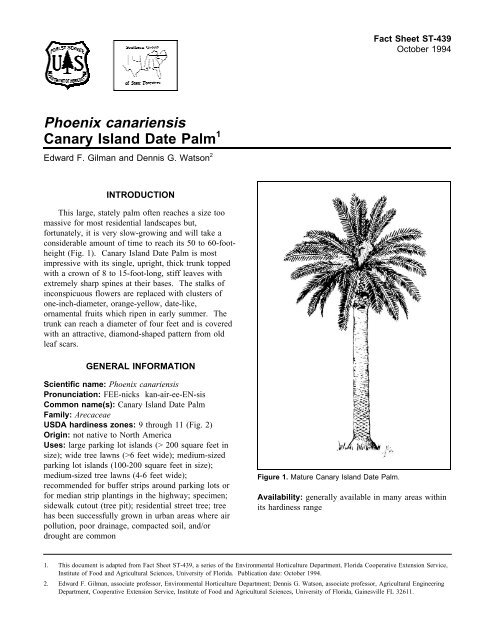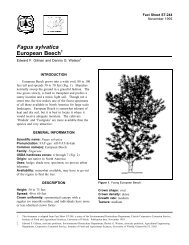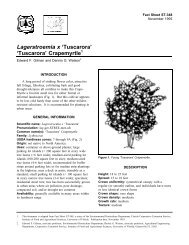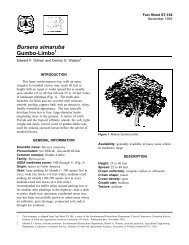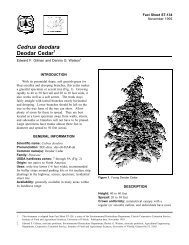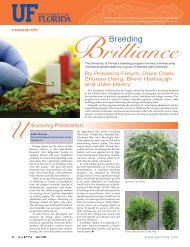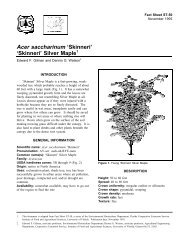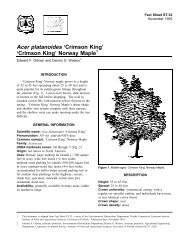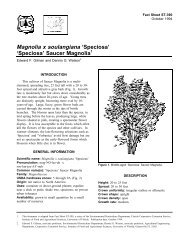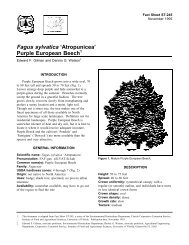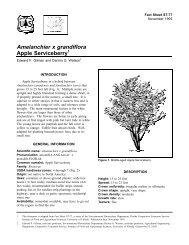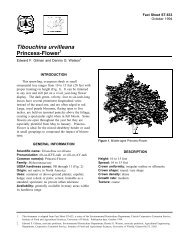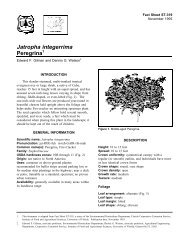Phoenix canariensis Canary Island Date Palm - Environmental ...
Phoenix canariensis Canary Island Date Palm - Environmental ...
Phoenix canariensis Canary Island Date Palm - Environmental ...
You also want an ePaper? Increase the reach of your titles
YUMPU automatically turns print PDFs into web optimized ePapers that Google loves.
<strong>Phoenix</strong> <strong>canariensis</strong><br />
<strong>Canary</strong> <strong>Island</strong> <strong>Date</strong> <strong>Palm</strong> 1<br />
Edward F. Gilman and Dennis G. Watson 2<br />
INTRODUCTION<br />
This large, stately palm often reaches a size too<br />
massive for most residential landscapes but,<br />
fortunately, it is very slow-growing and will take a<br />
considerable amount of time to reach its 50 to 60-footheight<br />
(Fig. 1). <strong>Canary</strong> <strong>Island</strong> <strong>Date</strong> <strong>Palm</strong> is most<br />
impressive with its single, upright, thick trunk topped<br />
with a crown of 8 to 15-foot-long, stiff leaves with<br />
extremely sharp spines at their bases. The stalks of<br />
inconspicuous flowers are replaced with clusters of<br />
one-inch-diameter, orange-yellow, date-like,<br />
ornamental fruits which ripen in early summer. The<br />
trunk can reach a diameter of four feet and is covered<br />
with an attractive, diamond-shaped pattern from old<br />
leaf scars.<br />
GENERAL INFORMATION<br />
Scientific name: <strong>Phoenix</strong> <strong>canariensis</strong><br />
Pronunciation: FEE-nicks kan-air-ee-EN-sis<br />
Common name(s): <strong>Canary</strong> <strong>Island</strong> <strong>Date</strong> <strong>Palm</strong><br />
Family: Arecaceae<br />
USDA hardiness zones: 9 through 11 (Fig. 2)<br />
Origin: not native to North America<br />
Uses: large parking lot islands (> 200 square feet in<br />
size); wide tree lawns (>6 feet wide); medium-sized<br />
parking lot islands (100-200 square feet in size);<br />
medium-sized tree lawns (4-6 feet wide);<br />
recommended for buffer strips around parking lots or<br />
for median strip plantings in the highway; specimen;<br />
sidewalk cutout (tree pit); residential street tree; tree<br />
has been successfully grown in urban areas where air<br />
pollution, poor drainage, compacted soil, and/or<br />
drought are common<br />
Figure 1. Mature <strong>Canary</strong> <strong>Island</strong> <strong>Date</strong> <strong>Palm</strong>.<br />
Fact Sheet ST-439<br />
October 1994<br />
Availability: generally available in many areas within<br />
its hardiness range<br />
1. This document is adapted from Fact Sheet ST-439, a series of the <strong>Environmental</strong> Horticulture Department, Florida Cooperative Extension Service,<br />
Institute of Food and Agricultural Sciences, University of Florida. Publication date: October 1994.<br />
2. Edward F. Gilman, associate professor, <strong>Environmental</strong> Horticulture Department; Dennis G. Watson, associate professor, Agricultural Engineering<br />
Department, Cooperative Extension Service, Institute of Food and Agricultural Sciences, University of Florida, Gainesville FL 32611.
<strong>Phoenix</strong> <strong>canariensis</strong> -- <strong>Canary</strong> <strong>Island</strong> <strong>Date</strong> <strong>Palm</strong> Page 2<br />
Figure 2. Shaded area represents potential planting range.<br />
DESCRIPTION<br />
Height: 40 to 60 feet<br />
Spread: 20 to 25 feet<br />
Crown uniformity: symmetrical canopy with a<br />
regular (or smooth) outline, and individuals have more<br />
or less identical crown forms<br />
Crown shape: palm; upright<br />
Crown density: open<br />
Growth rate: slow<br />
Texture: coarse<br />
Foliage<br />
Leaf arrangement: spiral<br />
Leaf type: odd pinnately compound<br />
Leaflet margin: entire<br />
Leaflet shape: linear<br />
Leaflet venation: parallel<br />
Leaf type and persistence: evergreen<br />
Leaflet blade length: 12 to 18 inches<br />
Leaf color: green<br />
Fall color: no fall color change<br />
Fall characteristic: not showy<br />
Flower<br />
Flower color: white<br />
Flower characteristics: inconspicuous and not<br />
showy; spring flowering; winter flowering<br />
Fruit<br />
Fruit shape: oval; round<br />
Fruit length: .5 to 1 inch<br />
Fruit covering: fleshy<br />
Fruit color: orange; yellow<br />
Fruit characteristics: attracts birds; suited for human<br />
consumption; no significant litter problem; showy<br />
Trunk and Branches<br />
Trunk/bark/branches: grow mostly upright and will<br />
not droop; showy trunk; should be grown with a single<br />
leader; no thorns<br />
Pruning requirement: needs little pruning to develop<br />
a strong structure<br />
Breakage: resistant<br />
Crown shaft: no
<strong>Phoenix</strong> <strong>canariensis</strong> -- <strong>Canary</strong> <strong>Island</strong> <strong>Date</strong> <strong>Palm</strong> Page 3<br />
Culture<br />
Light requirement: tree grows in full sun<br />
Soil tolerances: clay; loam; sand; acidic; alkaline;<br />
well-drained<br />
Drought tolerance: high<br />
Aerosol salt tolerance: moderate<br />
Other<br />
Roots: surface roots are usually not a problem<br />
Winter interest: no special winter interest<br />
Outstanding tree: tree has outstanding ornamental<br />
features and could be planted more<br />
Invasive potential: little, if any, potential at this time<br />
Verticillium wilt susceptibility: not known to be<br />
susceptible<br />
Pest resistance: very sensitive to one or more pests<br />
or diseases which can affect tree health or aesthetics<br />
USE AND MANAGEMENT<br />
<strong>Canary</strong> <strong>Island</strong> <strong>Date</strong> <strong>Palm</strong> should be grown in full<br />
sun on fertile, moist soil for best growth but is tolerant<br />
of any well-drained soil. It can be planted on the<br />
inland side of coastal condominiums and large homes<br />
due to moderately high salt-tolerance. It does well as<br />
a street or avenue tree, even in confined soil spaces.<br />
<strong>Canary</strong> <strong>Island</strong> <strong>Date</strong> <strong>Palm</strong> will require pruning to<br />
remove old fronds. Older leaves frequently become<br />
chlorotic from magnesium or potassium-deficiency.<br />
Preventive applications of appropriate fertilizer helps<br />
avoid this. Avoid damage to the trunk by locating it<br />
properly in the landscape and keeping landscape<br />
maintenance equipment away. Damaged trees are<br />
susceptible to Ganoderma rot.<br />
Only prune fronds which hang below the<br />
horizontal. Do not remove those growing upright<br />
since this may slow the growth and reduce vigor.<br />
Pests<br />
Propagation is by seed.<br />
Giant palm weevil can kill recently transplanted<br />
palms or those which are injured. Once in the palm,<br />
remedial control is not possible. Preventing injury is<br />
the best way to avoid the weevil. Some landscape<br />
managers conduct a preventive spray program<br />
following transplanting on these highly valued palms<br />
until they are well-established in the landscape.<br />
<strong>Palm</strong> leaf skeletonizer devours leaves.<br />
A variety of scale insects infest this palm.<br />
Diseases<br />
Mildly susceptible to lethal yellowing disease and<br />
leaf spot.<br />
Stressed and damaged trees often are infected with<br />
the Ganoderma fungus. A conk is formed at the base<br />
of the tree which appears as a varnished shelf or<br />
mushroom. Remove the conk and the tree to help<br />
control the spread of the disease to other plants.<br />
Prevent injury to the trunk and roots, and plant in<br />
well-drained soil. Be sure sprinklers do not irrigate<br />
the trunk so it remains wet. A wet trunk and wet soil<br />
encourage this disease. There is no control for butt<br />
rot, only prevention.


